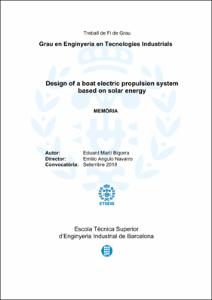Mostra el registre d'ítem simple
Design of a boat electric propulsion system based on solar energy
| dc.contributor | Angulo Navarro, Emilio |
| dc.contributor.author | Martí Bigorra, Eduard |
| dc.contributor.other | Universitat Politècnica de Catalunya. Departament de Resistència de Materials i Estructures a l'Enginyeria |
| dc.date.accessioned | 2018-10-24T09:48:45Z |
| dc.date.available | 2018-10-24T09:48:45Z |
| dc.date.issued | 2018-09-10 |
| dc.identifier.uri | http://hdl.handle.net/2117/122896 |
| dc.description.abstract | Existing boat market demands highlight the need to identify eco-friendly solutions which can compete with the actual fuel based propulsions and reduce the greenhouse effect in the earth and the noise produced in the sea. Today, sailboats are the main boat type in the market that can be equipped with solar panels. Other electric boat models also exist, however they have low speed specifications. Thus, the aim of this thesis is propose an electric propulsion system equipped with solar panels that can compete with fuel-based boats in terms of speed. This electric propulsion system pretends to fulfil one of the weaknesses of the actual electric boat market, where (equipped with solar panels supplying the propulsion batteries) only some sailboats and low speed motorboats are offered. To do so, the different main components (i.e the motor, the batteries and the solar panels) have been studied and chosen. In addition, a components connection scheme has been proposed. Besides of the motor and the batteries, the solution consists of a hardtop structure with solar panels placed on the roof in order to increase the available area to place the solar panels. To verify performance conditions, the hardtop design has been tested by FEM simulation (using ANSYS Workbench and Fluent) in different conditions (solar panels weight, snow conditions and wind conditions). In addition, with the aim to increase the vision factor between the sun and the solar panels installed in the roof of the hardtop, a solar panels orientation system has also been conceptually designed. In addition, with a few modifications in the hardtop structure the proposed electric propulsion system can be installed in any boat of an approximate range from 4,5 meters to 6,5 meters. Results indicate that weight of the designed propulsion system is higher than a conventional fuel propulsion system. However, the difference is not significant and it could be assumed by the hull of the boat. In the future, it is of interest to further develop the solar panels orientation system, realize an own design of the components and to analyse in deeper detail the adaptability of the proposed propulsion system to other boat models. |
| dc.language.iso | eng |
| dc.publisher | Universitat Politècnica de Catalunya |
| dc.rights.uri | http://creativecommons.org/licenses/by-nc-nd/3.0/es/ |
| dc.subject | Àrees temàtiques de la UPC::Enginyeria elèctrica |
| dc.subject.lcsh | Solar energy |
| dc.subject.lcsh | Electric motors |
| dc.subject.lcsh | Ship propulsion |
| dc.title | Design of a boat electric propulsion system based on solar energy |
| dc.type | Bachelor thesis |
| dc.subject.lemac | Motors elèctrics |
| dc.subject.lemac | Vaixells -- Propulsió |
| dc.subject.lemac | Energia solar |
| dc.identifier.slug | ETSEIB-240.134817 |
| dc.rights.access | Open Access |
| dc.date.updated | 2018-10-01T05:24:36Z |
| dc.audience.educationlevel | Grau |
| dc.audience.mediator | Escola Tècnica Superior d'Enginyeria Industrial de Barcelona |
| dc.audience.degree | GRAU EN ENGINYERIA EN TECNOLOGIES INDUSTRIALS (Pla 2010) |


